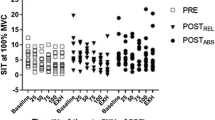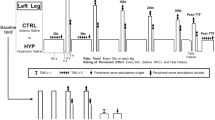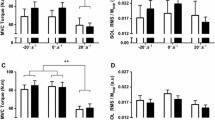Abstract
Purpose
This study aimed to investigate the hypothesis that a repeated bout of eccentric exercise (ECC2) would result in smaller increase in the sensitivity of spinal nociceptive system, and smaller decrease in the local muscle blood oxygenation response in both the ipsilateral and the contralateral tibialis anterior muscle (TA) when compared with the initial bout (ECC1). It was hypothesized that the magnitude of the repeated bout effect (RBE) would be greater for the ipsilateral side than the contralateral side.
Methods
Twenty-six healthy young men performed two bouts of high-intensity eccentric exercise of TA separated by 2 weeks. Half of the participants used the same leg for both bouts (IPSI) and the other half used the contralateral leg for ECC2 (CONTRA). Nociceptive withdrawal reflex threshold (NWRT) and local muscle blood oxygenation were assessed for the exercised TA muscle before, immediately after, and one day after exercise.
Results
Significant decreases in NWRT and muscle oxygenation were observed after ECC1 (p < 0.05), but NWRT did not change after ECC2 in both groups. Smaller decreases in muscle oxygenation were observed after ECC2 than ECC1 in both groups with a similar magnitude of the difference between bouts, but an increase in muscle oxygen re-perfusion before ECC2 was only observed in the IPSI group.
Conclusion
These results suggest that contralateral RBE was associated with spinal facilitation of the neuronal pathways situated at a homologous innervation level, and it is unlikely that oxygen re-perfusion improvement plays a major role in the contralateral RBE.



Similar content being viewed by others
Abbreviations
- CONTRA:
-
Contralateral
- DOMS:
-
Delayed onset muscle soreness
- ECC:
-
Eccentric exercise
- EMG:
-
Surface electromyography
- HHb:
-
De-oxyhemoglobin
- IPSI:
-
Ipsilateral
- MVC:
-
Maximum voluntary contraction
- NIRS:
-
Near infrared spectroscopy
- NWR:
-
Nociceptive withdrawal reflex
- NWRT:
-
Nociceptive withdrawal reflex threshold
- O2Hb:
-
Oxyhemoglobin
- PPT:
-
Pressure pain threshold
- RBE:
-
Repeated bout effect
- TA:
-
Tibialis anterior
- TSI:
-
Tissue saturation index
References
Andersen OK (2007) Studies of the organization of the human nociceptive withdrawal reflex. Focus on sensory convergence and stimulation site dependency. Acta Physiol (Oxf) 189(654):1–35
Banic B, Petersen-Felix S, Andersen OK et al (2004) Evidence for spinal cord hypersensitivity in chronic pain after whiplash injury and in fibromyalgia. Pain 107:7–15
Behrens M, Mau-Moeller A, Bruhn S (2012) Effect of exercise-induced muscle damage on neuromuscular function of the quadriceps muscle. Int J Sports Med 33:600–606
Biurrun Manresa JA, Neziri AY, Curatolo M, Arendt-Nielsen L, Andersen OK (2011) Test-retest reliability of the nociceptive withdrawal reflex and electrical pain thresholds after single and repeated stimulation in patients with chronic low back pain. Eur J Appl Physiol 111:83–92
Boushel R, Langberg H, Olesen J, Gonzales-Alonzo J, Bülow J, Kjaer M (2001) Monitoring tissue oxygen availability with near infrared spectroscopy (NIRS) in health and disease. Scand J Med Sci Sports 11:213–222
Brockett CL, Morgan DL, Proske U (2001) Human hamstring muscles adapt to eccentric exercise by changing optimum length. Med Sci Sports Exerc 33:783–790
Carroll TJ, Herbert RD, Munn J, Lee M, Gandevia SC (2006) Contralateral effects of unilateral strength training: evidence and possible mechanisms. J Appl Physiol 101:1514–1522
Connolly DA, Reed BV, McHugh MP (2002) The repeated bout effect: does evidence for a crossover effect exist. J Sports Sci Med 1:80–86
Dannecker EA, Koltyn KF (2014) Pain during and within hours after exercise in healthy adults. Sports Med 44:921–942
Davies RC, Eston RG, Poole DC et al (2008) Effect of eccentric exercise-induced muscle damage on the dynamics of muscle oxygenation and pulmonary oxygen uptake. J Appl Physiol 105:1413–1421
DeLorey DS, Kowalchuk JM, Paterson DH (2003) Relationship between pulmonary O2 uptake kinetics and muscle deoxygenation during moderate-intensity exercise. J Appl Physiol 95:113–120
Delwaide PJ, Pepin JL (1991) The influence of contralateral primary afferents on Ia inhibitory interneurones in humans. J Physiol 439:161–179
Faul F, Erdfelder E, Lang AG, Buchner A (2007) G*Power 3: a flexible statistical power analysis program for the social, behavioral, and biomedical sciences. Behav Res Methods 39:175–191
Felici F, Quaresima V, Fattorini L, Sbriccoli P, Filligoi GC, Ferrari M (2009) Biceps brachii myoelectric and oxygenation changes during static and sinusoidal isometric exercises. J Electromyogr Kinesiol 19:e1–e11
Ferrari M, Mottola L, Quaresima V (2004) Principles, techniques, and limitations of near infrared spectroscopy. Can J Appl Physiol 29:463–487
Fridén J, Seger J, Sjöström M, Ekblom B (1983) Adaptive response in human skeletal muscle subjected to prolonged eccentric training. Int J Sports Med 4:177–183
Hilgert Elcadi G (2012) Near infrared spectroscopy for assessing oxygenation and hemodynamics in the upper extremities of healthy subjects and patients with work-related muscle pain. Dissertation, Umeå University
Hortobagyi T, Lambert NJ, Hill JP (1997) Greater cross education following training with muscle lengthening than shortening. Med Sci Sports Exerc 29:107–112
Hosseinzadeh M, Andersen OK, Arendt-Nielsen L, Madeleine P (2013) Pain sensitivity is normalized after a repeated bout of eccentric exercise. Eur J Appl Physiol 113:2595–2602
Hosseinzadeh M, Andersen OK, Arendt-Nielsen L, Samani A, Kamavuako EN, Madeleine P (2015) Adaptation of local muscle blood flow and surface electromyography to repeated bouts of eccentric exercise. J Strength Cond Res 29:1017–1026
Howatson G, Van Someren K (2007) Evidence of a contralateral repeated bout effect after maximal eccentric contractions. Eur J Appl Physiol 101:207–214
Jankowska E, Edgley SA, Krutki P, Hammar I (2005a) Functional differentiation and organization of feline midlumbar commissural interneurones. J Physiol 565:645–658
Jankowska E, Krutki P, Matsuyama K (2005b) Relative contribution of Ia inhibitory interneurones to inhibition of feline contralateral motoneurones evoked via commissural interneurones. J Physiol 568:617–628
Johnson M, Polgar J, Weightman D, Appleton D (1973) Data on the distribution of fibre types in thirty-six human muscles: an autopsy study. J Neurol Sci 18:111–129
Kawczynski A, Samani A, Fernandez-de-Las-Penas C, Chmura J, Madeleine P (2012) Sensory mapping of the upper trapezius muscle in relation to consecutive sessions of eccentric exercise. J Strength Cond Res 26:1577–1583
Lavender AP, Nosaka K (2008) A light load eccentric exercise confers protection against a subsequent bout of more demanding eccentric exercise. J Sci Med Sport 11:291–298
Lee M, Carroll TJ (2007) Cross education: possible mechanisms for the contralateral effects of unilateral resistance training. Sports Med 37:1–14
Madeleine P, Cescon C, Farina D (2006) Spatial and force dependency of mechanomyographic signal features. J Neurosci Methods 158:89–99
Magnusson S, Simonsen EB, Aagaard P, Moritz U, Kjaer M (1995) Contraction specific changes in passive torque in human skeletal muscle. Acta Physiol Scand 155:377–386
Matcher SJ, Kirkpatrick PJ, Nahid K, Cope M, Delpy DT (1995) Absolute quantification methods in tissue near-infrared spectroscopy. pp 486–495
McHugh MP (2003) Recent advances in the understanding of the repeated bout effect: the protective effect against muscle damage from a single bout of eccentric exercise. Scand J Med Sci Sports 13:88–97
Mense S (1993) Nociception from skeletal muscle in relation to clinical muscle pain. Pain 54:241–289
Munn J, Herbert R, Gandevia S (2004) Contralateral effects of unilateral resistance training: a meta-analysis. J Appl Physiol 96:1861–1866
Muthalib M, Lee H, Millet GY, Ferrari M, Nosaka K (2011) The repeated-bout effect: influence on biceps brachii oxygenation and myoelectrical activity. J Appl Physiol 110:1390–1399
Nosaka K, Clarkson PM (1995) Muscle damage following repeated bouts of high force eccentric exercise. Med Sci Sports Exerc 27:1263–1269
Nosaka K, Newton M (2002) Repeated eccentric exercise bouts do not exacerbate muscle damage and repair. J Strength Cond Res 16:117–122
Pierrynowski MR, Tudus PM, Plyley MJ (1987) Effects of downhill or uphill training prior to a downhill run. Eur J Appl Physiol Occup Physiol 56:668–672
Pizza FX, Koh TJ, McGregor SJ, Brooks SV (2002) Muscle inflammatory cells after passive stretches, isometric contractions, and lengthening contractions. J Appl Physiol 92:1873–1878
Quaresima V, Homma S, Azuma K et al (2001) Calf and shin muscle oxygenation patterns and femoral artery blood flow during dynamic plantar flexion exercise in humans. Eur J Appl Physiol 84:387–394
Rhudy JL, France CR (2007) Defining the nociceptive flexion reflex (NFR) threshold in human participants: a comparison of different scoring criteria. Pain 128:244–253
Seber GAF, Wild CJ (2003) Nonlinear Regression. Wiley-Interscience, Hoboken
Shima N, Ishida K, Katayama K, Morotome Y, Sato Y, Miyamura M (2002) Cross education of muscular strength during unilateral resistance training and detraining. Eur J Appl Physiol 86:287–294
Starbuck C, Eston RG (2012) Exercise-induced muscle damage and the repeated bout effect: evidence for cross transfer. Eur J Appl Physiol 112:1005–1013
Vangsgaard S, Nørgaard LT, Madeleine P, Taylor JL (2014) Crossed responses found in human trapezius muscles are not H-reflexes. Muscle Nerve 49:362–369
Warren GL, Lowe DA, Armstrong RB (1999) Measurement tools used in the study of eccentric contraction-induced injury. Sports Med 27:43–59
Warren GL, Hermann KM, Ingalls CP, Masselli MR, Armstrong R (2000) Decreased EMG median frequency during a second bout of eccentric contractions. Med Sci Sports Exerc 32:820–829
Xin L, Hyldahl RD, Chipkin SR, Clarkson PM (2014) A contralateral repeated bout effect attenuates induction of NF-kappaB DNA binding following eccentric exercise. J Appl Physiol 116:1473–1480
Yasuda Y, Miyamura M (1983) Cross transfer effects of muscular training on blood flow in the ipsilateral and contralateral forearms. Eur J Appl Physiol Occup Physiol 51:321–329
Acknowledgments
The authors would like to thank Dr. EN Kamavuako (Aalborg University, Denmark) for methodological recommendations regarding the use of NIRS.
Conflict of interest
No conflicts of interest, financial, or otherwise, are declared by the authors.
Author information
Authors and Affiliations
Corresponding author
Additional information
Communicated by Toshio Moritani.
Rights and permissions
About this article
Cite this article
Hosseinzadeh, M., Samani, A., Andersen, O.K. et al. Ipsilateral resistance exercise prevents exercise-induced central sensitization in the contralateral limb: a randomized controlled trial. Eur J Appl Physiol 115, 2253–2262 (2015). https://doi.org/10.1007/s00421-015-3205-x
Received:
Accepted:
Published:
Issue Date:
DOI: https://doi.org/10.1007/s00421-015-3205-x




